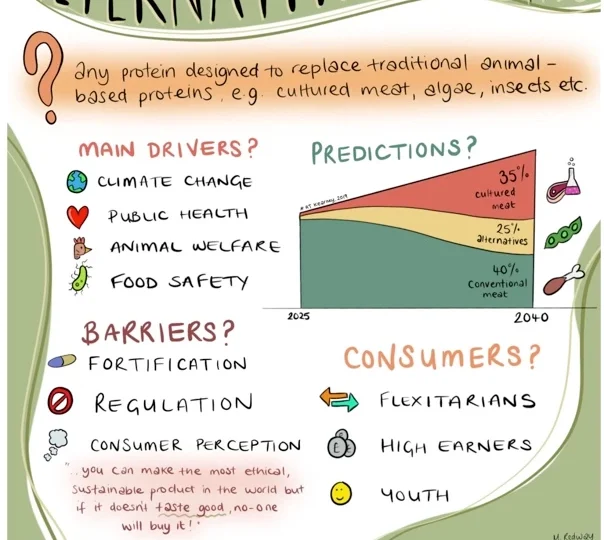The current transformation of our future food system is something we have not seen since the Green Revolution almost fifty years ago. The number of start-ups and larger companies developing alternative protein products to respond to the growing consumer demand has increased dramatically: From 2017 to 2019 sales of plant-based foods grew 29% in the U.S. to $5 billion according to The Good Food Institute. This has been fueled by entrepreneurs taking advantage of the reduced costs of R&D to develop new products and investors seeing the enormous market potential for alternative proteins to feed a population that will exceed 9 billion in 2050.
The term Alternative Proteins
Alternative proteins refer to proteins intended to replace proteins derived from animals such as proteins derived from plants, animal cell culture, microorganisms, and insects. Plant-based products include plant-based milk, plant-based meats and seafood, tofu and tempeh, plant-based dairy alternatives to cheese, yogurt, butter, mayonnaise, ice cream, and eggs. There are also cultivated or lab-grown meat companies producing beef, chicken, pork, and a variety of seafood products. There is also a range of products and food ingredients being produced with algae and through fermentation. Insect proteins are also being used to create everything from chips and beer to burgers and pasta. Although not unique to alternative proteins, there are also a number of companies developing 3D printers that can create plant-based beef steaks (Redefine meat).
The United States is at the forefront of this transformation
In the United States, the transformation has been in large part due to a shift in consumer demand for plant-based proteins designed to look and taste like meat or other animal products. Other countries are witnessing similar trends, especially Canada, the UK, France, Germany, Israel, Singapore, Switzerland, and China. A number of new companies have emerged with global reach such as Beyond Meat, Impossible Foods, and EAT JUST with more than $1 billion in funding together and others developing alternatives to seafood, cheese, yogurt, butter, mayo, algae, fermentation and 3D printing. Yet we are still five to ten years away from having cultivated or lab-grown meats or lab-grown seafood widely available to consumers.

Foodservice companies have also gotten on board, among big restaurant chains, Burger King has launched a vegetarian version of its flagship “Whopper,” while McDonald’s has unveiled a meatless burger in Germany. Kentucky Fried Chicken has begun to roll out its plant-based fried chicken in the US. Giant Food and commodity players like Nestlé, Kellogg, Danone, Maple Leaf, Cargill, and ADM have also launched new alternative protein products and brands.
Even prior to the outbreak of Covid-19, JP Morgan had estimated that the market for plant-based meat could easily top 100 billion USD in 15 years. Similarly, Barclays had predicted that the alternative meat market could account for around 10 percent of all global meat sales, or up to $140 billion in 10 years. With Covid-19 we have seen an acceleration of these trends, with some companies reporting a tripling of sales, and others racing to register new trademarks at a rate not seen before.
So, what is driving consumers to look for alternatives to animal protein?
Consumers are concerned about reducing the environmental impact of livestock production and also over the use of water, pesticides, fertilizers, hormones, and antibiotics in the livestock production process. Consumers are also concerned about their health, and the link to high consumption of animal products, especially red meat, and the increased risk of chronic diseases like heart disease, type 2 diabetes, stroke, and certain cancers. Animal welfare is a third driver behind this trend, with demand for meat growing at twice the rate of the population, leading to an estimated 75 billion animals be slaughtered each year. In some regions, food safety is also a major driver given a history of contaminated animal products being sold to consumers.
Consumers who are purchasing alternative proteins also tend to be younger (Generation Z and X, and Millennials) and from higher-income groups. They are also mainly flexitarians, people reducing animal products in their diets but continuing to eat meat. A survey in the US found that 52% of Americans were trying to reduce the amount of meat in their diets.
The nutrition perspective: Plant-based Meat is not Meat
Nutrition has not been a major driver behind consumers purchasing decisions. But this is beginning to change: A number of plant-based meat substitutes are ultra-processed, with high amounts of sodium, with ingredients and additives including flavorings, coloring, and binding agents. They also sometimes contain novel ingredients such as that used to replicate the heme iron, derived from a GMO soy ingredient. Other products that mimic well animal protein but do not have the same micro- and macronutrients or amino acid profile as meat has. “Based on the limited evidence to date, it is unknown whether replacing farmed meats with plant-based substitutes would offer comparable nutritional or chronic disease reduction benefits as replacing meats with whole legumes,” researchers comment in a newly published study from August 2020.
This makes it a challenge to include alternative protein products in national Dietary Guidelines: A plant-based burger patty does not deliver the same amount of nutrients as a meat burger does. The good news is that the major companies producing these products are trying to address these challenges with each new version they release and there are more and more products that are “cleaner” with limited processing and ingredients.
The transformation of our food system has started and there will be more and more products replacing animal-derived products in supermarkets. At the current stage, alternative protein products cannot be recommended in official dietary guidelines and food pyramids. There is a lack of scientific data on the impacts of these alternative proteins on human health. Once this is done, these products will be incorporated in official guidelines – and then they will be recommended as nutritious or less nutritious to be consumed in only small amounts.
My personal observation is that over the next ten years we will see better versions of alternative protein products, tailored to nutritional needs. We will also see more consumer acceptance and availability of products at affordable prices, also in Low and Middle-Income Countries.
This article was written by Marc Van Ameringen, Co-founder and Director of the Future Food Platform which supports start-ups and larger companies developing alternative proteins and other game-changing food innovations by helping them get to scale. This article is based on the event “Alternative Proteins Radically Change our Diets but are they nutritious?” organized by Nutrition Hub and Future Food Platform on 16th Sept 2020 with Taylor Quinn, Director Emerging Markets EAT JUST and Kyla Hagedorn, founder AnuLife.










